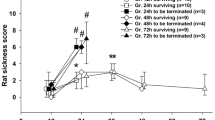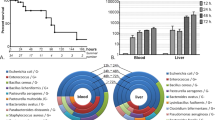Abstract
In previous attempts to produce a murine model of gastrointestinal listeriosis, the authors observed that pentobarbital anesthesia greatly increased disease severity in mice that were esophageally inoculated with the bacterium Listeria monocytogenes. In this study, they sought to evaluate the severity of systemic infection in inoculated mice that were anesthetized with isoflurane, an inhalational agent that is safer than pentobarbital and more commonly used for rodent anesthesia. Compared with pentobarbital anesthesia, isoflurane anesthesia resulted in infections of lesser severity, similar to those observed in unanesthetized mice. A pilot study in which mice were anesthetized with isoflurane for 5, 10 or 20 min suggested that this effect was not related to the duration of anesthesia. These results show that isoflurane anesthesia administered for 5 to 20 min does not potentiate the severity of listeriosis infection in mice esophageally inoculated with L. monocytogenes.
This is a preview of subscription content, access via your institution
Access options
Subscribe to this journal
We are sorry, but there is no personal subscription option available for your country.
Buy this article
- Purchase on Springer Link
- Instant access to full article PDF
Prices may be subject to local taxes which are calculated during checkout

Similar content being viewed by others
References
Ramaswamy, V. et al. Listeria—review of epidemiology and pathogenesis. J. Microbiol. Immunol. Infect. 40, 4–13 (2007).
Low, J.C. & Donachie, W. A review of Listeria monocytogenes and listeriosis. Vet. J. 153, 9–29 (1997).
Hamon, M., Bierne, H. & Cossart, P. Listeria monocytogenes: a multifaceted model. Nat. Rev. Microbiol. 4, 423–434 (2006).
Czuprynski, C.J., Faith, N.G., Steinberg, H. & Neudeck, B. Sodium pentobarbital anesthesia transiently enhances the severity of infection following intragastric, but not intravenous, inoculation of Listeria monocytogenes in mice. Microb. Pathog. 35, 81–86 (2003).
Swaminathan, B. & Gerner-Smidt, P. The epidemiology of human listeriosis. Microbes Infect. 9, 1236–1243 (2007).
Pilgrim, H.I. & Deome, K.B. Intraperitoneal pentobarbital anesthesia in mice. Exp. Med. Surg. 13, 401–403 (1955).
Pine, L. et al. Listeria monocytogenes ATCC 35152 and NCTC 7973 contain a nonhemolytic, nonvirulent variant. J. Clin. Microbiol. 25, 2247–2251 (1987).
Cheng, Y., Yue, L., Elhanafi, D. & Kathariou, S. Absence of serotype-specific surface antigen in laboratory variants of epidemic-associated Listeria monocytogenes strains. Appl. Environ. Microbiol. 73, 6313–6316 (2007).
Siebert, J.N., Posfay-Barbe, K.M., Habre, W. & Siegrist, C.A. Influence of anesthesia on immune responses and its effect on vaccination in children: review of evidence. Paediatr. Anaesth. 17, 410–420 (2007).
Teramoto, S. et al. Investigation of effects of anesthesia and age on aspiration in mice through LacZ gene transfer by recombinant E1-deleted adenovirus vectors. Am. J. Respir. Crit. Care Med. 158, 1914–1919 (1998).
Kona-Boun, J.J., Silim, A. & Troncy, E. Immunologic aspects of veterinary anesthesia and analgesia. J. Am. Vet. Med. Assoc. 226, 355–363 (2005).
Galley, H.F., DiMatteo, M.A. & Webster, N.R. Immunomodulation by anaesthetic, sedative and analgesic agents: does it matter? Intensive Care Med. 26, 267–274 (2000).
Bette, M. et al. Influence of different anaesthetics on pro-inflammatory cytokine expression in rat spleen. Lab. Anim. 38, 272–279 (2004).
Janssen, B.J. et al. Effects of anesthetics on systemic hemodynamics in mice. Am. J. Physiol. Heart Circ. Physiol. 287, H1618–H1624 (2004).
Brodbelt, D.C., Harris, J. & Taylor, P.M. Pituitary-adrenocortical effects of methoxamine infusion on halothane anaesthetised ponies. Res. Vet. Sci. 65, 119–123 (1998).
Taylor, P.M. Effects of hypertonic saline infusion on the adrenocortical response to thiopental-halothane anesthesia in sheep after premedication with acepromazine. Vet. Surg. 28, 77–82 (1999).
Salman, H. et al. Effect of sodium thiopentone anesthesia on the phagocytic activity of rat peritoneal macrophages. Life Sci. 63, 2221–2226 (1998).
Hunter, J.D. Effects of anaesthesia on the human immune system. Hosp. Med. 60, 658–663 (1999).
Correa-Sales, C., Tosta, C.E. & Rizzo, L.V. The effects of anesthesia with thiopental on T lymphocyte responses to antigen and mitogens in vivo and in vitro. Int. J. Immunopharmacol. 19, 117–128 (1997).
Nishina, K. et al. The inhibitory effects of thiopental, midazolam, and ketamine on human neutrophil functions. Anesth. Analg. 86, 159–165 (1998).
Szekely, A., Heindl, B., Zahler, S., Conzen, P.F. & Becker, B.F. Nonuniform behavior of intravenous anesthetics on postischemic adhesion of neutrophils in the guinea pig heart. Anesth. Analg. 90, 1293–1300 (2000).
Tian, J. et al. Gamma-aminobutyric acid inhibits T cell autoimmunity and the development of inflammatory responses in a mouse type 1 diabetes model. J. Immunol. 173, 5298–5304 (2004).
Alam, S., Laughton, D.L., Walding, A. & Wolstenholme, A.J. Human peripheral blood mononuclear cells express GABAA receptor subunits. Mol. Immunol. 43, 1432–1442 (2006).
Tian, J., Chau, C., Hales, T.G. & Kaufman, D.L. GABA(A) receptors mediate inhibition of T cell responses. J. Neuroimmunol. 96, 21–28 (1999).
Barker, J.L. & Ransom, B.R. Pentobarbitone pharmacology of mammalian central neurones grown in tissue culture. J. Physiol. 280, 355–372 (1978).
Lubick, K., Radke, M. & Jutila, M. Securinine, a GABAA receptor antagonist, enhances macrophage clearance of phase II C. burnetii: comparison with TLR agonists. J. Leukoc. Biol. 82, 1062–1069 (2007).
Acknowledgements
We thank Dr Sophia Kathariou from North Carolina State University's Department of Food Sciences for providing us with Listeria monocytogenes strain F2381L. The study was funded by the National Research Initiative of the USDA Cooperative State Research, Education, and Extension Service (grant number 2005-35201-15313), by a special cooperative agreement with the National Alliance for Food Safety and Security, and by the Walter and Martha Renk Endowed Laboratory for Food Safety.
Author information
Authors and Affiliations
Corresponding author
Ethics declarations
Competing interests
The authors declare no competing financial interests.
Rights and permissions
About this article
Cite this article
Sahaghian, R., Faith, N. & Czuprynski, C. Comparison of systemic Listeria monocytogenes infection in esophageally inoculated mice anesthetized with isoflurane or pentobarbital. Lab Anim 38, 126–130 (2009). https://doi.org/10.1038/laban0409-126
Received:
Accepted:
Issue Date:
DOI: https://doi.org/10.1038/laban0409-126



